Delivered
We’re sending Johnny
The transport chain is being digitalized Oatly values a modern vehicle fleet


We’re sending Johnny
The transport chain is being digitalized Oatly values a modern vehicle fleet

With over 20 years of experience of international road transports Scandic Trans is a well-known player in Scandinavia and Europe. The company, which at the same time works as an umbrella organization for its joint owners and contracted hauliers, is characterized by close customer relations, a strong connection to the shareholders and hauliers and have clear niches.
Since the founding of the company during the late 1980’s the company’s most important task has been to assist the small haulage contractors when it comes to customers, shipping companies and other parties, both operationally and administratively. In the background there is a strong owner base willing to back vehicles and service, reliable drivers and a loyal and experienced staff.
Today 35 haulage contractors are involved in the company – as joint owners, contractors or subcontractors.
– The main principle is that the company should strive to create opportunities for the hauliers business. The haulage and ownership are strongly connected. It is our goal for all the shareholders to also be contracted hauliers, CEO Mikael Löfqvist tells us.
The Nordic countries and Scandinavia make up the company’s biggest market, and the head office
• Med över 20 års erfarenhet av internationella landsvägstransporter är Scandic Trans en välkänd aktör inom Skandinavien och Europa.
• Företaget, som samtidigt fungerar som en paraplyorganisation för sina delägare och åkerier, kännetecknas av nära kundrelationer, en stark koppling till aktieägare och trafikanter samt tydliga nischer.

• Idag är 35 åkerier delaktiga i företaget – antingen som delägare, avtalstrafikanter eller underleverantörer.
• Norden och Skandinavien utgör företagets största marknad, och huvudkontoret finns beläget i Korsholm strax utanför Vasa på den finlandssvenska västkusten. Vid sidan om detta har företaget även terminaler och personal i Åbo, Vanda, Helsingborg och Stockholm.
is located in Mustasaari right outside Vaasa on the Finno-Swedish west coast. In addition to this the company has terminals and personnel also in Turku, Vantaa, Helsingborg and Stockholm.
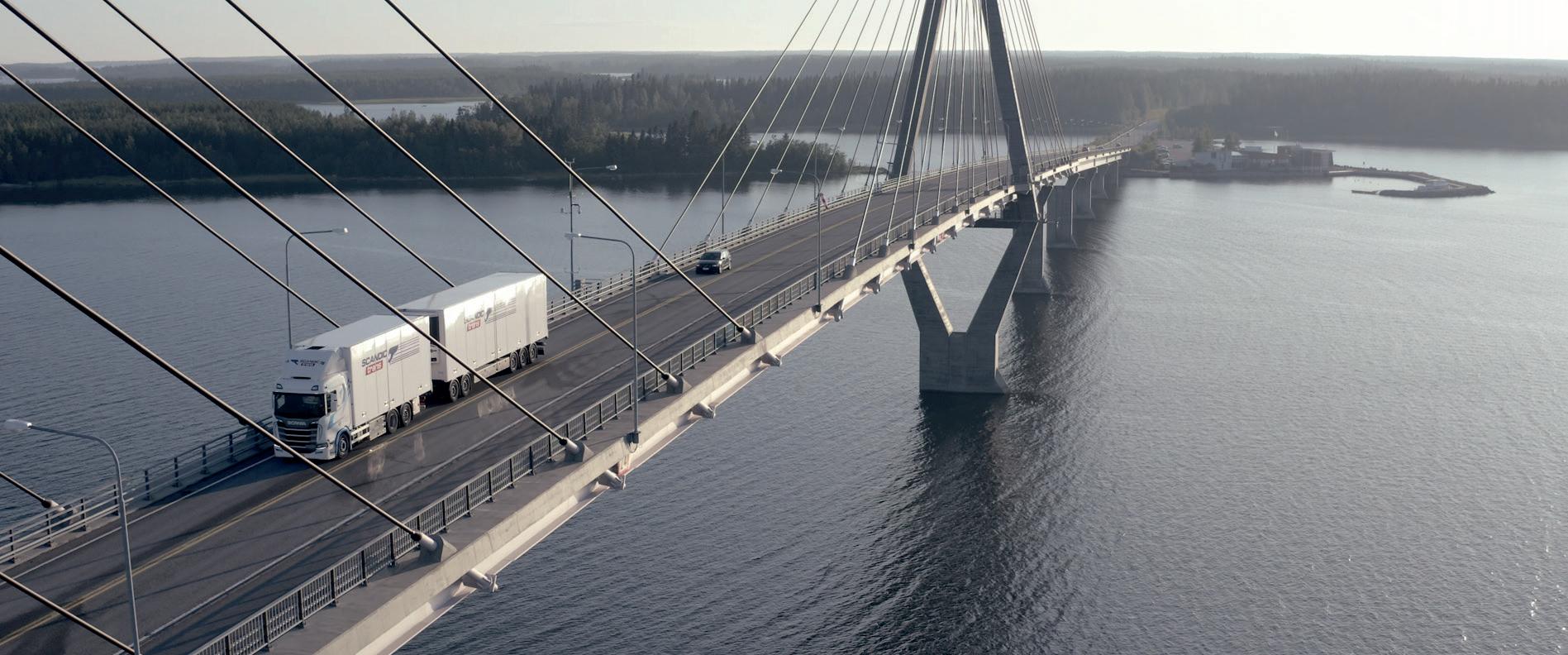
Scandic Trans has specialized in foodstuff transports - often temperature sensitive - as well as transport of pharmaceuticals and hazardous substances.
– We dispose a modern vehicle fleet adapted to everything from transportation of mixed cargo groupage to temperature regulated transport and transport of hazardous substances. All transports are also carried out as express haulage from door to door, Löfqvist adds.
Besides this Scandic Trans also provides transport of oversized goods and different services for airfreight companies – export and import dispatch services, terminal operations and temperature regulated storage and local distribution.
Two basic corner stones for the business are crucial: Scandic Trans’ customers all have their own, designated transport leader and the same driver loads, transports and unloads – with a personal responsibility for the goods. Scandic Trans is the personal company in a relatively impersonal branch of industry.
• Scandic Trans on tunnettu toimija Pohjoismaissa ja Euroopassa. Meillä on yli 20 vuoden kokemus kansainvälisistä maantiekuljetuksista.
• Yritykselle, joka palvelee sekä osakkaitaan että huolintaliikkeitä, on ominaista läheiset asiakassuhteet, voimakas yhteys osakkeenomistajiin, liikennöitsijöihin ja markkinoihin.
• Yrityksessä on osallisena 35 liikennöitsijää – joko osakkaana, sopimusliikennöitsijänä tai alihankkijana.
• Yrityksen suurimmat markkinat ovat Pohjoismaissa ja pääkonttori sijaitsee Mustasaaressa, aivan Vaasan kupeessa ruotsinkielisellä länsirannikolla. Yrityksellä on lisäksi terminaaleja ja henkilökuntaa Turussa, Vantaalla, Helsingborgissa ja Tukholmassa.
The transport trade is an extremely exciting and changing one to work in right now. The digitalization renews and simplifies for everyone. At the same time an increasingly fierce competition forces us to constantly sharpen our range of services.
Scandic Trans is currently in an expansion phase and our goal during the upcoming years is to become a leading Nordic and Northern European player, with a stable yearly growth, increased digitalization and expanded all-encompassing services. We already have some of the trade’s best key figures when it comes to on-time deliveries, delays and complaints.
We’re sending Johnny! By now you might have come across Scandic Trans’ communication concept and wonder: who is Johnny? Johnny is everybody, but still no one in particular here at the company.
But above all it is the mantra of a personal company in a pretty impersonal trade. No matter when and how you contact us you always get a name and a contact person who helps you all the way. With every transport. All year round. It is a part of our success concept and something we hope that you as our customer experience with every transport.
Our purpose with this magazine is to present interesting and current information for all our interest organizations, something for everybody.
Happy reading,
Mikael Löfqvist, CEO Scandic Trans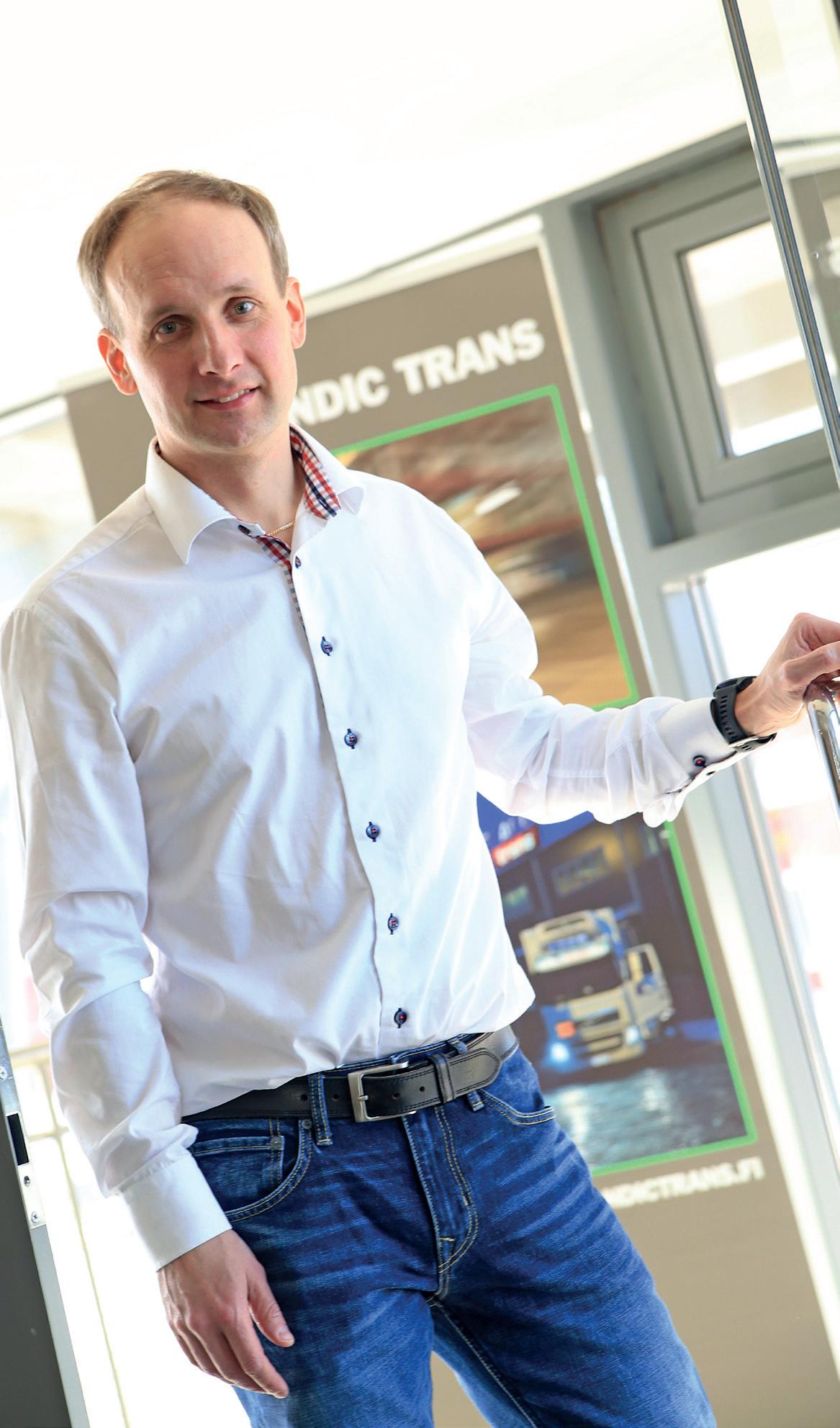
You are holding the very first customer newspaper from Scandic Trans, and we would very much like to know Your thoughts on it! That way we can satisfy the readers’ wishes before the next issue, which is scheduled to be published in the fall 2020.
Leave us Your feedback via the questionnaire which can be found on www.scandictrans.fi/newletter and You have the chance of winning a new iPad. The winner is randomly chosen among all the participants no later than 31.12.2019 and Scandic Trans will contact the winner personally.
Thank You and good luck!

Scandic Trans Lagervägen 14
FI-65610 Korsholm
Finland
+358 20 120 2500
www.scandictrans.fi
Production: bySand och Kustmedia Ab
Editorial: Mikael Löfqvist, Anna Sand, Lisbeth Bäck
Text & Picture: Anna Sand, if nothing else is mentioned
Translation: SVENG translations
Layout: Emilia Häggman/Kustmedia Ab
Printing: Korsholms Tryckeri
Edition: 2000 copies
Cover: Anna Sand/bySand
As a customer, you should experience our transport services as straight forward and simple. That of course includes fantastic customer service. We are here for you around the clock and you get your own contact person. We call him Johnny – but it might as well be Joakim or Richard, Linda or Fredrik. All focused on your unique transport. We at Scandic Trans are simply Johnny with you.
Johnny treats all customers the same way – he’s Johnny with everyone. Johnny is our customer relations personified – our promises to our customers personified. Whatever you need - no problem. We’re sending Johnny.
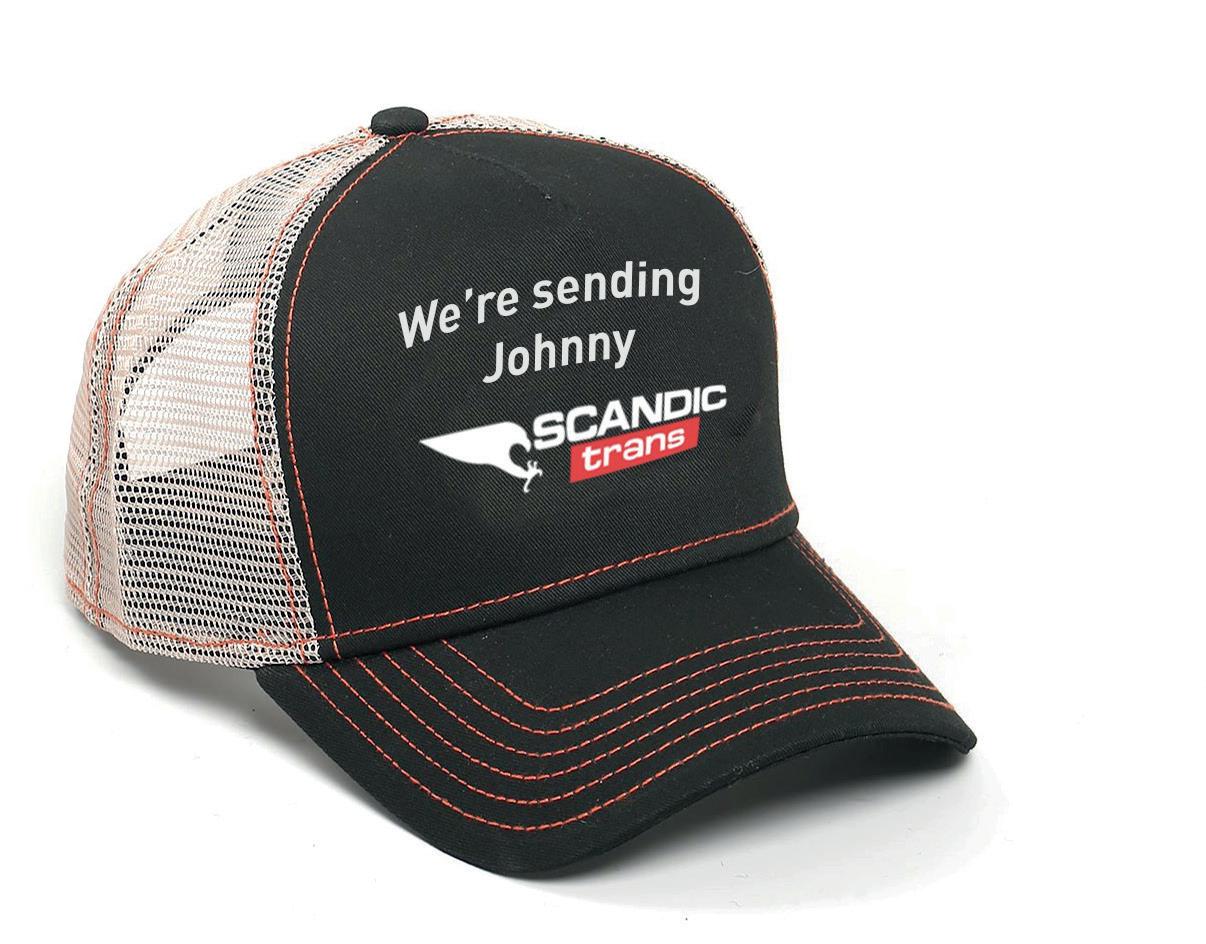
Som kund är vårt mål att du ska uppleva transporten av dina varor som enkel. Just därför ingår mycket mer än bara transporten. Oavsett om ditt gods ska transporteras varmt, kallt, i expressfart eller som farligt gods, håller vi vad vi lovar och du vet vad du kan förvänta dig av oss – nämligen branschens bästa totalupplevelse.
I den ingår självfallet en oöverträffbar kundservice. Vi finns alltid till hands, dygnet runt och du får din egen kontaktperson hos oss. Vi kallar honom Johnny – men det kan lika gärna vara Joakim eller Richard, Linda eller Fredrik. Alla med fokus på just din unika transport. Alla vi på Scandic Trans är helt enkelt Johnny med dig. Johnny är vår kundrelation till dig personifierad – våra löften till våra kunder personifierade. Vad du än behöver, så är det inget problem. Vi skickar Johnny.

Tavoitteemme on, että asiakkaamme kokevat tavaroiden kuljetuksen helpoksi. Siksi palveluun kuuluu niin paljon muuta kuin pelkkä kuljetus. Oli tuotteitasi kuljetettava lämpimänä, kylmänä, pikana tai vaarallisena tavarana, me pidämme lupauksemme ja sinä tiedät mitä voit meiltä odottaa – nimittäin alan parhaan kokonaisuuskokemuksen.
Siihen sisältyy tietysti lyömätön asiakaspalvelu. Me olemme täällä ympäri vuorokauden. Saat oman yhteyshenkilön. Me kutsumme häntä Johnnyksi – mutta hän voisi yhtä hyvin olla Joakim tai Richard, Linda tai Fredrik. Kaikki keskittyvät juuri sinun ainutlaatuiseen kuljetukseesi. Kaikki me Scandic Transilla olemme yksinkertaisesti Johnnyjä kanssasi. Johnny on meidän asiakassuhteemme sinun kanssasi. Mitä ikinä tarvitsetkaan, me tarjoamme ratkaisun. Me lähetämme Johnnyn.
With almost three decades in the rear-view mirror Scandic Trans celebrates its 30 year anniversary in 2020. The company was founded in 1990 when five separate haulers, with their own vehicles and traffic permits joined forces. Today two of them are still on board as shareholders of which Trans Sandås spearheaded by Göran Sandås is one.
– We had a decent start because we acquired the company Sand Trans and took over their whole vehicle fleet and customer base, their employees as well as the property here at Fågelberget, where Scandic Trans still operates, Göran explains.
Kurt Löfqvist was hired as the company’s first CEO, who also contributed with a broad contact network from his previous workplace. He remembers it as a challenging but exciting time.
– We were on the verge of a banking crisis and depression in Finland, so the timing was not ideal. There was however optimism among joint owners, management and personnel, so the work never felt heavy, Kurt tells us. Everyone pitched in and there were never any signs on resignation.
The turnover increased continuously and the business, which was more regulated
before the European Union, was liberalized after the union entry during the middle of the 90’s.
– It made the transports both faster and more efficient, Kurt remembers.
The Finnish paper industry made up an important customer group during the first years and with time the company has specialized in temperature controlled transports. Göran Sandås worked as transport manager and was also the chairman of board during the first years.

– Already then we operated all over the Nordic countries, and also Russia, he remembers.
The owner structure has changed somewhat during the years and today there are, besides the biggest joint owners also some 30 other shareholders who are active hauliersin the company. The corner stones are still the same for the company, which still consists of ”hauliers” interested in solving practical matters, driving well-functioning vehicles and making sure that the goods reach their destination in the same state as when they were loaded - On Time In Full.
The original founders of Scandic Trans: Kuljetusliike Antti & Jussi Rahja Kuljetusliike J & T Pöyhtäri Kuljetusliike H Pöyhtäri Transport Johan Rosenqvist Trans Sandås
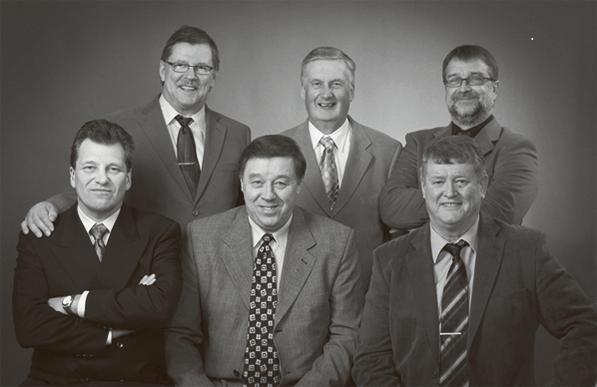
• Yritys perustettiin 1990 kun viisi yksityistä liikennöitsijää liittyivät yhteen. Yrityksen ensimmäiseksi toimitusjohtajaksi palkattiin Kurt Löfqvist.
• Suomalainen paperiteollisuus muodosti tärkeän asiakasryhmän ensimmäisten vuosien aikana, jonka jälkeen yritys on erikoistunut lämpösäädeltyihin kuljetuksiin.
• Omistusrakenne on muuttunut jonkin verran vuosien aikana ja tänään ensimmäisten osakkeenomistajien lisäksi yrityksellä on kolmisenkymmentä muuta osakkeenomistajaa, jotka ovat aktiivisia liikennöitsijöitä.
• Företaget grundades 1990 då fem enskilda åkare, med egna fordon och trafiktillstånd, gick samman. Som företagets första VD anställdes Kurt Löfqvist.
• Den finländska pappersindustrin utgjorde en viktig kundgrupp under de första åren och vartefter har företaget specialiserat sig på tempererade transporter.
• Ägarstrukturen har förändrats en del under åren, och idag finns förutom de största delägarna också ett 30-tal andra aktieägare som är aktiva trafikanter i bolaget.
The Malax Loaf’s history dates all the way back to 1893. The bread, which is still baked today according to the over 100-year-old recipe, was back then shipped in to the marketplace in Vaasa from the bakery in Åminne, Maalahti, with rowing boats equipped with sails. Today the logistics looks somewhat different, and the market spans across not only all of Finland, but now also all over Sweden.
The typical, but also distinctive archipelago loaf quickly became a favourite in the Swedish speaking coastal area in western Finland. The recipe is still today a well-kept secret, even though the company’s owner has shifted a couple of times.


– It is still a family business, says Janette Peltokoski, whose parents took over the company in 2001.
The change of ownership became the starting signal for a massive marketing effort both domestically and in the western neighbouring country. A long-term job that has produced results, but which still continues. The Malax Loaf is now well established not only with retailers all around Finland, but also within the country’s food service industry. The same process is ongoing in Sweden.
– We began the marketing in Sweden in the northern part of the country, from Umeå and northward, Janette tells us. The reception has been very positive, and the Malax Loaf is now distributed to all the big Swedish wholesalers – ICA, Axfood, Coop and Bergendahl, she continues.
Establishing a to Sweden completely new product has required a lot of hard work and also patience.
– The export of the Malax Loaf has increased constantly and there is more potential. We see that there is a lot of confidence in Finnish products and the quality they represent. Finnish quality is appreciated abroad and people know that we are meticulous with our raw material, manufacturing process and hygiene. We have reason to be proud, Janette figures.
An important factor for the export is functioning and quick logistics – especially when it comes to foodstuff. The Malax Loaf has ever since the first loaves were shipped over Kvarken collaborated with Scandic Trans.
– We load the trucks every Wednesday and the week’s goods are transported down to Scandic Trans’ terminal in Turku, where they are reloaded for further ferry transport over to Stockholm. In Sweden they are then driven out to the customers’ central storage facilities according to preset times. The loaves reach the customers the day after they have been collected, which is important, Janette explains. The decision to use Scandic Trans as their collaborator is based on several different factors.
– For one they are a local company close to us, and they give us immediate response and service. The transports also happen quickly and with appropriate vehicles. Our wishes have been taken into consideration and it is easy to have a dialogue with Scandic Trans. If a problem for some reason ever would occur they contact us straight away. They feel close on all levels.
Graavilohivoileipä
Maalahden
Maalahden Limppu
Hyvää graavilohta
Tuore kurkku
Tzatziki kurkkusalaatti
Tuore salaatti


1 paket skivad Malax Limpa
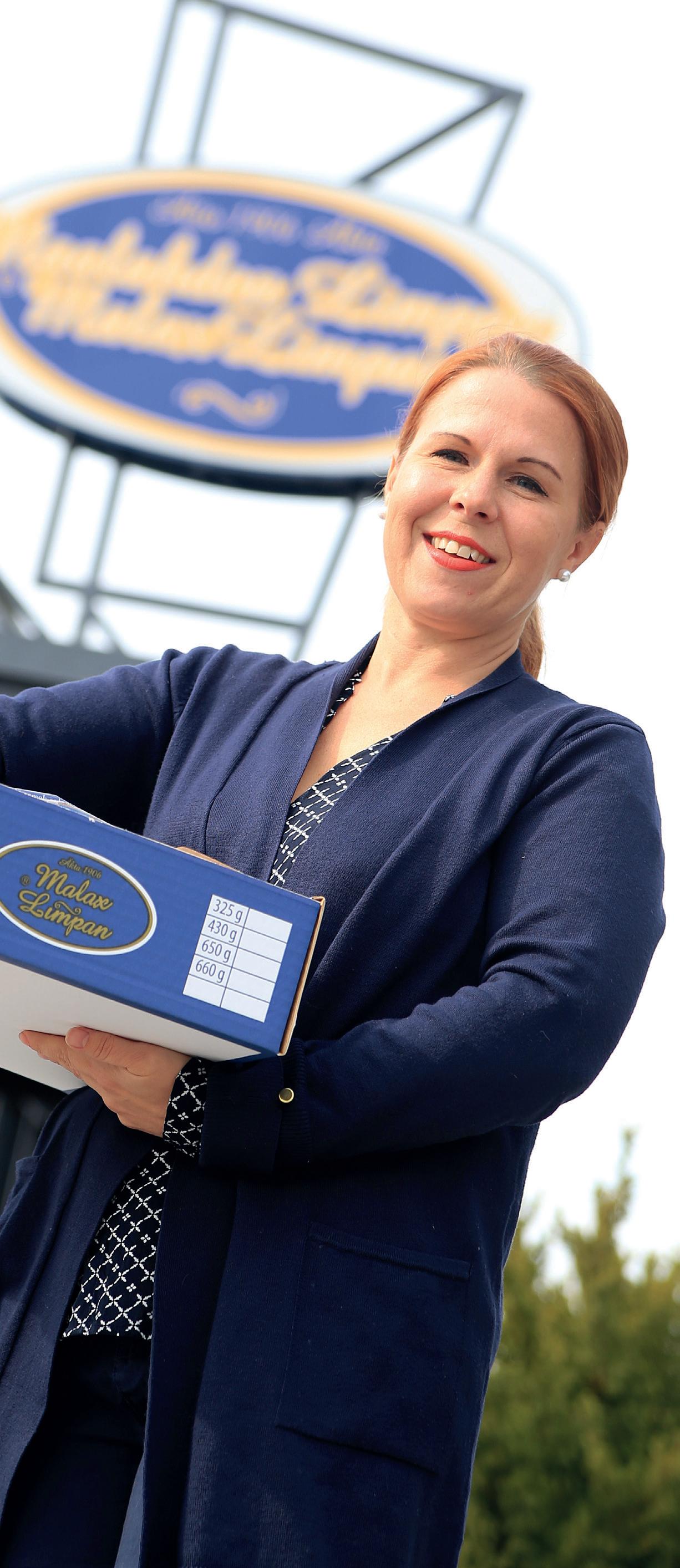
1 dl kokande vatten
1/4 grönsaksbuljongtärning
250 g turkisk yoghurt
1 dl riven gurka
1 vitlöksklyfta
en nypa salt
1-2 dl groddar
100g fetaost
Topping:
Vintersallat
1 dl groddar
50 g fetaost
1 liten rödlök i ringar
5-10 miniplommontomater
Skär bort kanterna på brödskivorna. Koka upp vattnet och lös upp grönsaksbuljongtärningen. Lägg tre brödskivor bredvid varandra och fukta dem. Mät upp yoghurten i en skål och riv gurkan. Pressa överlopps vätska ur gurkan och häll den rivna gurkan i yoghurten. Pressa i vitlöksklyftan och smaksätt med en nypa salt.
Bred en tredjedel av fyllningen på brödskivorna och strö på groddarna. Lägg på det andra lagret bröd, fukta och bred på en tredjedel av fyllningen. Strö på tärnad eller smulad fetaost. Lägg på det tredje lagret bröd och bred på resten av fyllningen. Garnera med vintersallat, groddar, tärnad fetaost, rödlöksringar och miniplommontomater. Ställ in tårtan i kylen för en stund innan den serveras.
Joakim Lerbacka, transport manager, Marcus Rosenqvist, haulier and joint owner and also Richard Romar, project coordinating market developer, believes that the customers choose Scandic Trans thanks to their flexibility and close customer relations.
Scandic Trans, which also can be described as an umbrella organization to its joint owners and haulage contractors, is characterized by close customer relations and a strong connection to shareholders and hauliers. When a few of them gather around the same table they agree on most things – among other that the type of ownership which Scandic Trans represents is the best system for everybody involved.
Marcus Rosenqvist is a second-generation transport entrepreneur. He, together with his brother Björn, has incrementally taken over the company their father founded, J Rosenqvist Ab. Today the company has eleven transport trucks, two vehicles for gravel transport and 14 employees. Marcus’ father was also one of the people who founded Scandic Trans.
– The reason was to understand the business better - and it has paid off. The joint ownership has given us totally different opportunities to assess whether you should go for it and invest more – or not. As a board member I have the possibility to influence the company’s development and direction, which feels rewarding. At the same time, it is also a challenge to put your own company aside during the board meetings and focus only on Scandic Trans – what we want to achieve together and how, Marcus notes.
As haulier – and also drivers – Marcus and his employees follow both Scandic Trans’ haulage-agreement and driver’s manual, which are regulated by the company’s policy with the aim of maintaining the level of quality. In the driver’s manual there are client specific instructions, which are completed on the company’s intranet whenever new bookings are made.
– The development has gone in the direction that more and more loading and unloading times are set, and the customer has higher and higher demands, Marcus continues, and Joakim Lerbacka, who has worked as transport manager at Scandic Trans for 16 years, agrees.
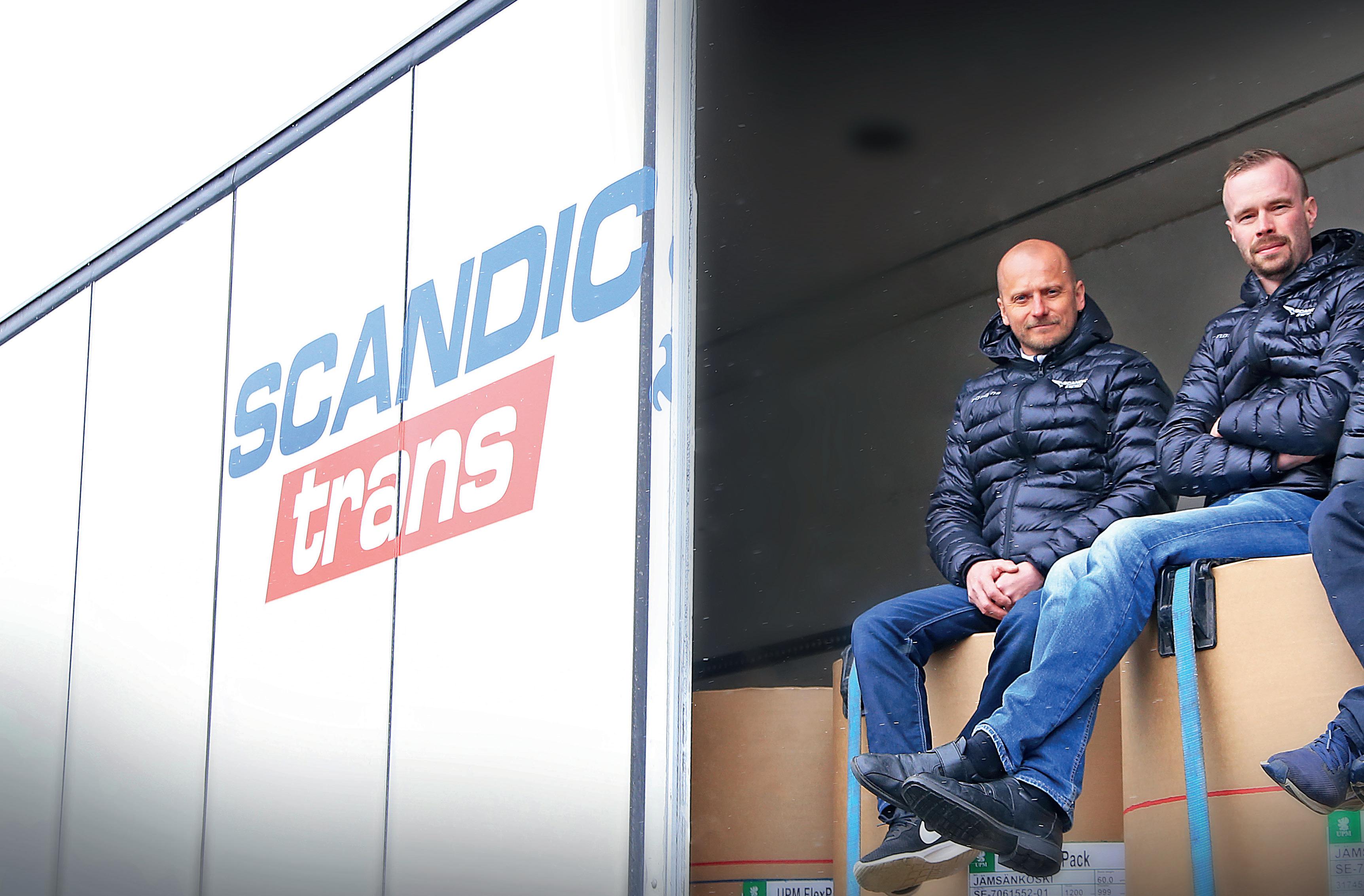
Joakim directs the trucks based on the booking made by the customers.
– The goal is to coordinate the traffic as efficiently as possible, taking into consideration the customers timetable and the drivers work time. The truck load space must be fully loaded every time. The customers themselves more and more want to avoid having their own storage facilities – we make up their storage today, Joakim states.
Tangibly the work has been made easier thanks to the digitalization, and nowadays the drivers don’t even need to have a laptop with them in the car – the
Oy Trans Sandås Ab
Rosenqvist J Ab
Kuljetusliike TJN-Transport Siipola Oy

Öström Pro Trans Oy
Lassfolk Transportaffär Ab Oy
Kuljetusliike Marko Pohja Oy
Ab B & M Karlssons Åkeri Oy
Kallion Kuljetus Oy
Oy Bengt Dahlgren Ab
TJV-Kuljetus
Kuljetus J. Kuusela Oy
Eekoo Express Oy
Hoplog Oy
Jakkulan Kuljetus Ky
BE GE-Trans Gustafsson Ab
Kuljetus V. Kujala Oy
Kuljetusliike Väätäinen Oy
Kuljetusliike M. Kytölä Oy
Kukjetusliike VP Hämälinen Ky
R & L Lithén
Rahkola Aki
Rectra Oy
RH-Trans Oy LTD
Trans B Ginström Ab
Trans Jesse Vähärautio Ky
Trans-Södergård Ab
Äbb Marko
Ähtärin Transpet Oy
Österholm Tom
Oy Vikstrand Ab
The joint ownership has given us totally different opportunities to assess whether you should go for it and invest more – or not.
cell phone is enough, since everything is run via a mobile app.
– At the same time, we have to be available for the drivers around the clock, and at the office all departments work closely together, Joakim adds.
Joakim and Marcus both agree that the customers choose Scandic Trans thanks to the quick response, the flexibility and the feeling that they are close to them.
– The individual contact can be crucial for many, they think.
Richard Romar, the project coordinating market developer, continues:
– Responsiveness is also key, especially when finding new customers and markets. One has to be able to see new possibilities and gateways and be able to decide what gives added value to different clients. Here the fieldwork is incredibly important, Richard thinks.
Equally important as it is to find new customers it is to take care of the existing ones. After Sales is in other words just as important.
Scandic Trans’ customer records includes 11 000 companies, of which around 5 000 are active customers.
Still it is the ten biggest who make up the most part of the company’s turnover.
– Some of our customers have been with us from the very beginning, Richard tells us.
Scandic Trans’ goal is to provide overall solutions that include all of Europe, not only the Nordic countries – and the traffic is already running in France, the Benelux countries and Germany. The next step is Poland.
– We are already working on it, because more and more of the Finnish industrial companies are moving their business there, Richard explains.
Freedom with responsibility is a recurring incentive during the discussion.
– As joint owners we ourselves make the decisions, and since we are a relatively small organisation, we can make quick decisions. Nobody needs to wait for everything to pass through a big corporate group, and for the hauliers to have an ownership in the company is a long term and fair solution, the trio concludes.
As CEO for the Finnish-Swedish chamber of commerce, which helps Finnish companies establish themselves on the Swedish market, Kjell has a good outline of the commerce and different structures in both countries.
– Sweden is with its ten million inhabitants twice as big as Finland, and there are both differences and similarities between the countries, Kjell starts. The industrial structure is about the same in both countries, but Sweden has many globally leading companies within both industry and consumption.

The Swedish companies have built their export business during a long period of time and has a strong knowledge about both B2B and B2C.
– Currently the Swedish export industry benefits from the weak Swedish krona, which on second thought raises the prices on imported goods, Kjell explains.
The international presence is also much bigger in Sweden, with more international companies and a more multicultural job market.
– Sweden and mainly Stockholm has managed to emerge as ”The capital of the Nordic countries”. It gives a big advantage in the struggle for investments and competent work force. Almost all foreign corporate groups’ Nordic head offices are based in Stockholm, Kjell continues.
The countries differ from each other also logistically. The transports to and from Finland are for geographical reasons dependent on transport at sea and a bit over 80 percent of goods delivered within Finland’s foreign commerce happen by ship.
Born in Kristiinankaupunki in Ostrobothnia and with a degree in foreign commerce from Vasa Handelsläroverk in his back pocket Kjell Skoglund has spent a big part of his career within different organizations and built an expansive contact network in the Nordic countries. Today he is the CEO of the Finnish-Swedish chamber of commerce seated in Stockholm and helps Finnish companies build bridges to Sweden.
– As a result of the climate change there is an open discussion in Sweden about the possibilities to improve the railway connections to Central Europe. But the starting position is of course different in Finland and Sweden, Kjell states.
Kjell describes the Swedish consumers as very quality-conscious, often with higher demands than the Finnish.
PHOTO: Marica Rosengård– Sweden is also a more international market with a tougher competition within all sections. For companies who want to broaden their business to the Swedish market Kjell says that the starting position is very good.
– The Swedish market has similar structures to the Finnish and is relatively familiar to most people. Even so, one should not assume that everything works exactly the same way, he adds.
Digitalization affects most sections in the community and is therefore one of the strongest driving forces. It is a theme discussed during most of the seminars we arrange and my impression is that the carrier companies are alert and closely follow the industry’s development.
One condition in order to make it is to do your research properly.
– Don’t rush into a new market without a good enough overall picture of the competition and potential clients. Gather all the facts – there are several agencies that can give advice and guidance. The Finnish-Swedish chamber of commerce can help find potential clients and collaborators and our counselling service also includes questions regarding taxation and legislation.
The chamber of commerce’s counsellor has a broad knowledge about the Swedish market and the organisation arranges seminars and happenings where they offer relevant information about the Swedish market.
– As a member of the chamber of commerce one becomes part of the extensive network of companies that the chamber of commerce maintains in both countries, Kjell adds.
How does then the business activity between Finland and Sweden work on a general level?
According to Kjell the contacts between the countries have developed in a very positive direction during a long period of time.
– The Nordic integration has progressed much stronger on an economical level than for example on a political. A driving force has been the many fusions and acquisitions made mainly between Finnish and Swedish companies.
Despite this there is still a big unused potential to strengthen the exchange between the countries.
– Holding it up are among other things many administrative border obstacles that affect both individuals and companies, Kjell says.
Two questions overshadowing the economy today are the digitalization and climate issue.
– Digitalization affects most sections in the community and is therefore one of the strongest driving forces. It is a theme discussed during most of the seminars we arrange, and my impression is that the carrier companies are alert and closely follow the industry’s development.
The biggest challenge is still the climate discussion, which very much so affects the transport business.
– It would be wise for the industry itself to present solutions and spearhead the development. Then the threat can be turned into possibilities, Kjell thinks. A common denominator for both countries, and all of the Nordic countries, is the solid know-how when it comes to technology and vehicle manufacture.
– It creates opportunities to make the Nordic countries a predecessor for smart traffic and logistics solutions. Therefore, I hope for a close collaboration between the carrier companies, the vehicle manufacturers and the technology section to which also many start-up companies belong.
The confidence in our authorities is also strong internationally. If we with joint efforts in the Nordic countries manage to create standards for future transport solutions the preconditions are good for making these internationally approved, Kjell concludes.
Our community is being more and more digitalized and also the logistics needs to keep up. Decisions in principle in order to speed up the development have been made by both the Finnish Government and within the EU, and an electronic information flow has long been prioritized within Scandic Trans.
An important question when it comes to digitalization is how the information can be better utilized in order to direct the flow of goods. Finland is a country with long distances and therefore higher transport costs than the average within the EU. Lowering the costs would mean a lot for the Finnish companies’ competitiveness. The vision for 2025 is that Finland has managed to use its geographical location and with the help of digitalization measures has become a hub also for international freight transports.
Finland is number one in the world when it comes to promoting the mind-set mobility as a service. It is important that this know-how is used within the freight logistics.

– The transport capacity is not used to its fullest today, nor nationally or internationally – there is a lot of air in the transport, which is both expensive and ineffective. A lot of money could be saved by striving towards a maximally used loading space – something that in turn requires a booking system which is being updated in real-time, Stefan Nyholm, CEO for the company Nextlog in Mustasaari on the Finnish west coast, explains.
The driving of empty trucks can be minimized, and the filling of the space maximized – something digitalization enables.
– In the end it is about improving the profitability at the same time as saving the environment – a win-win situation for all parties, he states.
Nyholm is a former transport entrepreneur who soon 20 years ago became an IT entrepreneur because of their own need for an extensive transport and logistics system. Today Nextlog delivers its system LogiControl with related modules to Finnish transport companies, whose vehicles move around all of Europe.
The World Economic Forum has estimated the global benefit from digitalization of the logistics trade to 1 500 billion dollars and for the community to 2 400 billion dollar up until 2025. On EU-level it is estimated that the digitalization will lower the carbon dioxide emissions by 15-30 percent.
– We adopted the digitalization very early on and already in the beginning of 2000 had computers and modems with GPRS connections in our cars. A lot has happened since, Nyholm notes. LogiControl covers the whole process from order management to billing and follow-up, and is an excellent example of the true Ostrobothnia spirit ”we can do it ourselves”.
The development has according to Nyholm accelerated the last five years and a lot of work now goes into integrating their own system with other systems. The goal is that the same data should not have to be inserted many times by different players.
– This is the challenge – that there isn’t one single common standard, but several different formats. The systems do not communicate with each other, and it is the same within other trades.
– In order to create integration between them it also requires that several parties cooperate, Nyholm continues. It can become very complex, especially when it involves intermodal transports and many different players.
Robert Nyman works as counsellor and expert for the association Finlands Yrkestrafik r.f., which was founded in
2015 with the purpose of protecting the interests of those who drive for a living. He points out the need for standardized solutions, but at the same stresses that Finland in some cases are ahead of development compared to several other countries.
– This concern especially the digitalization level of profession specific educations, which nowadays can be done with a web platform. Starting July 2019, all ADR driving license examinations are carried out electronically, he explains.
An electronic follow-up system when it comes to the driver competence and permits should be integrated with the existing solution – something that also has been realized at Nextlog.
Nyman also states that the use of electronic waybills is slowly but surely developing.
– On the tanker front and also when it comes to timber transport one has used electronic waybills for a long time in Finland, but when it comes to international transports, it requires agreement by all parties, which is not a given, Nyman adds.
In April 2019 Finland adopted an international convention for electronic waybills, consisting currently of 18 countries.
Considering the digitalization of the whole transport chain, it is important that the electronic data can be used also for communication with the authorities – something that for the time being is awaiting authority’s decisions. This acceptance is now to be supported by EU regulation already in the pipeline.
• Finland’s foreign commerce with Sweden has risen the past recent years. It was at its lowest in the spring 2016 after a longer declining trend, but after the turning point the numbers have been increasing.
• Sweden is Finland’s second biggest trading partner when it comes to the export of goods, and the biggest when it comes to the export of services.
• The strong Euro is still putting on the brakes, but in Finland the Sweden commerce is instead supported in an exemplary way with the help of different players. The Finnish-Swedish chamber of commerce is one important such player.
• Periaatepäätös kehityksen nopeuttamiseksi on tehty Suomen Valtioneuvostossa sekä EU-tasolla ja Scandic Trans on jo pitkään priorisoinut sähköistä tiedonkulkua.
• Suomi on edelläkävijä sähköisten palvelujen edistäjänä maailmassa. On tärkeää, että tätä tietotaitoa hyödynnetään tavaraliikenteen logistiikassa.
• Haasteena on, että ei ole olemassa yhtä yhteistä standardia, vaan useita erilaisia. Järjestelmät eivät keskustele keskenään.
• Maailman talousfoorumi on arvioinut globaalin digitalisaation hyödyn olevan logistiikka-alalle 1 500 miljardia dollaria ja yhteiskunnalle 2 400 miljardia dollaria vuoteen 2025 mennessä.
• EU-tasolla digitalisaation arvioidaan voivan saavuttaa hiilidioksidipäästöjen vähenemisen 15-30 prosentilla.
Total
31.7.2019
Food
• Principbeslut för att påskynda utvecklingen har fattats både av Finlands statsråd och på EU-nivå och Scandic Trans har redan länge prioriterat ett elektroniskt informationsflöde.
• Finland är främst i världen när det gäller att främja tankesättet mobilitet som tjänst. Det är viktigt att detta kunnande utnyttjas inom godslogistiken.
• Utmaningen är att det inte finns en enda gemensam standard, utan fler olika format. Systemen pratar inte med varandra.
• Världsekonomiska forumet har uppskattat att den globala nyttan av digitaliseringen av logistikbranschen till 1 500 miljarder dollar och för samhället till 2 400 miljarder dollar fram till 2025.
• På EU-nivå uppskattas digitaliseringen kunna åstadkomma en minskning på 15-30 procent av koldioxidutsläppen.
Electric
Other
Chemicals
31.7.2019
Petroleum
Chemicals
Total
Source: Tulli.fi
candic Trans has specialized in temperate transport of different kinds and from Oatly in southern Sweden products are daily shipped to Finland in all three segments - ambient, chilled and frozen goods. Oatly currently finds itself in great expansion phase and besides an increasingly higher product capacity also the logistic puzzle becomes more and more intricate.
Oatly was founded in the nineties after researchers at the university in Lund made the revolutionizing discovery that natural enzymes can transform fibrous oats into nutritious, liquid food, perfectly suited for humans.

Today the method is patented and Oatly works dedicatedly on with its mission: to improve the wellbeing of both individuals and the whole planet with a product assortment that takes its powers from oats.
– We want to make it easy for people to eat and drink in a way that makes them feel good and at the same time don’t have to worry about wasting the planet’s resources, Linda Nordgren, the company’s Communication Manager, explains.

With head office in Malmö and production and development facilities in Landskrona the southern part of Sweden is Oatly’s home turf. The brand name soon exists in 30 countries and a new production facility has recently opened in the USA. Next up is the Netherlands.
– Oatly’s turnover is expected to double this year and we currently find ourselves in a great expansion phase with an explosive rise when it comes to the demand of the oat products, Linda explains.
Meeting the increasing demands has been a daily struggle during the beginning of 2019, and puts pressure also on the raw material producers, the subcontractors and the carrier companies they collaborate with. Scandic Trans has for several years been one of them.
– Our growth has demanded great flexibility from the carrier companies, and we are very pleased with
Oatly’s turnover is expected to double this year and we currently find ourselves in a great expansion phase with an explosive rise when it comes to the demand of the oat products, Linda explains.
Scandic Trans. Finished products are daily loaded onto vehicles for transport to Finland, where they are unloaded at our retailers’ central storage facilities, tells Andreas Johansson, Logistic & Distribution Manager at Oatly.
The volumes transported over the Baltic Sea are constantly increasing and the trucks are getting more and more loaded.
We value a modern vehicle fleet with as little climate influence as possible and transparency when it comes to emissions and other numbers from our logistics partners. It’s also important to have a good dialogue, Andreas continues.
– New and bigger solutions have been needed all along and the cooperation has run very smoothly.
After last year’s dry summer in Sweden the domestic production of oats has not been enough for this year, and therefore we have also imported Finnish oats from Helsingin Mylly.
– Also for this purpose we have used Scandic Trans for transport. Of the total oats consumption in Landskrona this year 20-25 percent comes from Finland and the Baltic States, Andreas adds.
Sustainability is key for Oatly, also when it comes to choosing collaborators.
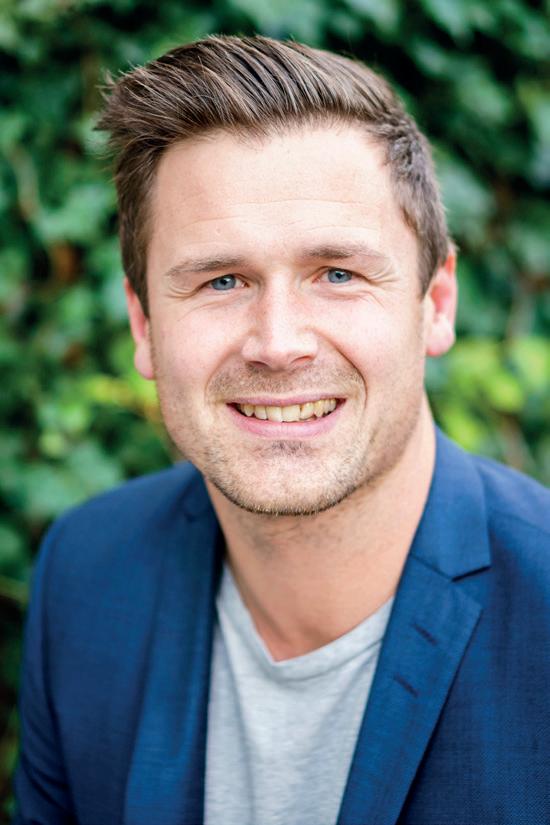
– We value a modern vehicle fleet with as little climate influence as possible and transparency when it comes to emissions and other numbers from our logistics partners. It’s also important to have a good dialogue, Andreas continues.
Nowadays Oatly’s products are also marked with information about how the product affects the climate.
– If one compares the carbon footprint of one litre of Oatly oat drink in Sweden and Finland, it here in Sweden makes up 0,27 kg CO2e/litre. After transport to Finland the number has not risen to more than 0,29 kg CO2e/litre. The transport to Finland means an increase of only seven percent when considering the whole life span of the oat drink, Linda concludes.
Oatly uses mainly local ( Sweden) produced oats, but uses also imported drought oats from Finland and the Baltic states.
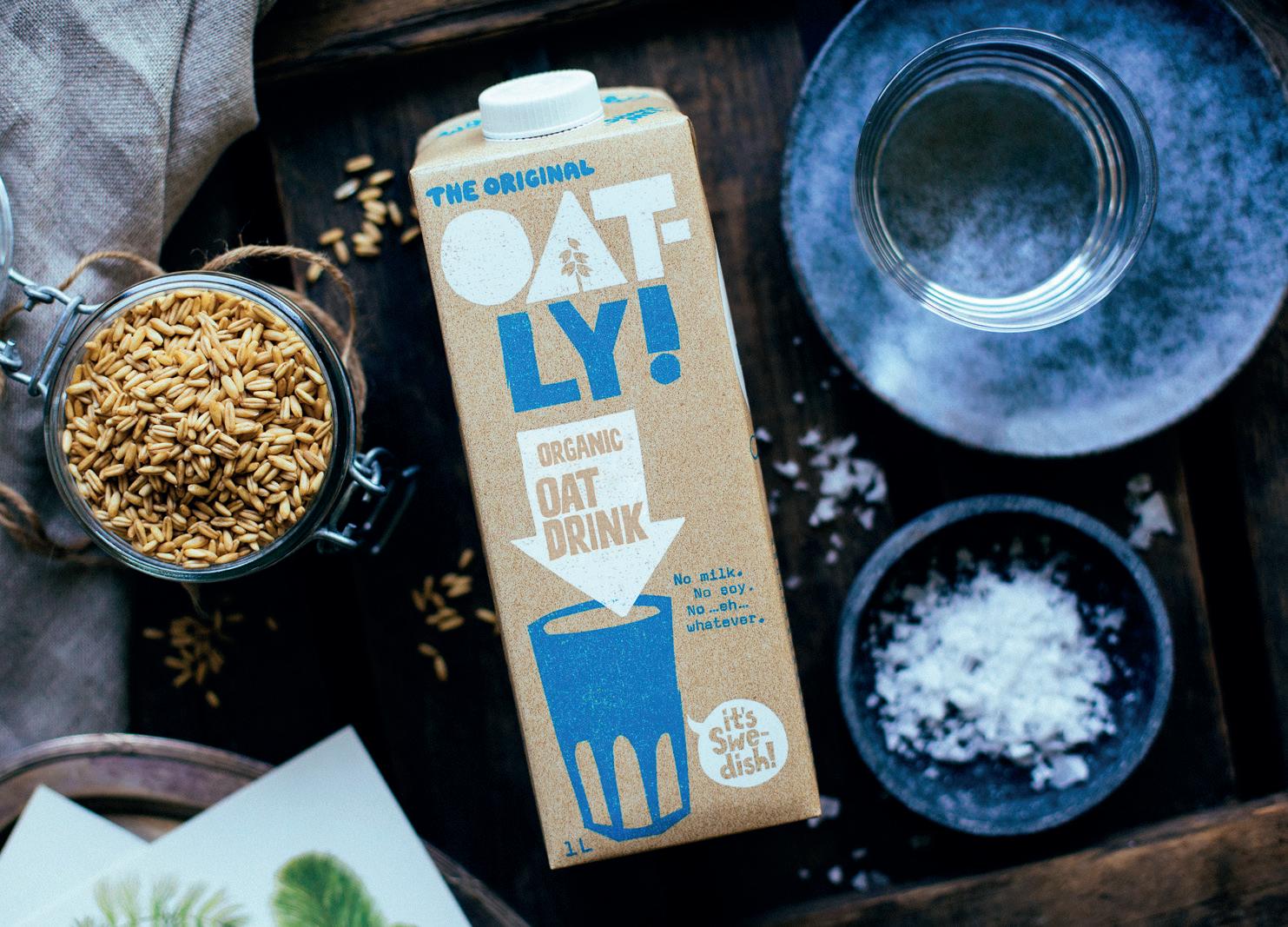
Not only private cars, but also more and more heavy vehicles on our roads are driven by alternative fuel. The leading companies in the trade agree that the climate change needs to be taken seriously and that renewable fuel is a crucial factor for a sustainable logistics sector.
The road to more sustainable solutions for heavy vehicles and more eco-friendly truck transports is mainly liquefied natural gas, LNG. The environmental demands and threats of a diesel ban drives the trend forward, and LNG will be here quicker than many thought.
– Many speak of the pros and cons of diesel engines – but it is not a question about the engine itself, product manager at Scania Mika Jukkara points out. It is about what fuel is used.
The newly developed Scania Euro 6 gas engine works as the proven Otto-motor. A lot of development has been focused on raising the engine’s efficiency, which now is only a few percent under the diesel engine. When it comes to
As with all fuels also the LNG market is dependent on political decisions. In the long run nor LNG or LBG can replace all diesel today. Biogas is the more interesting alternative if we are talking bigger quantities.
performance, they are equal.
– The engine is also three decibels quieter than the corresponding diesel, which feels like half the sound level since the decibel curve is logarithmic.
With LNG in the tank the trucks not only become quieter –the carbon dioxide emissions also decreases with as much as 20 percent. Natural gas is however still a fossil fuel and the long-term vision is to move over to the renewable alternative, liquefied biogas. Not until then we will get the big climate advantage.
LNG and LBG are completely exchangeable and the engine don’t know the difference. While we wait for a technique
that produces bigger volumes of LBG the trucks’ gas tanks can be filled with LNG.
With LNG a heavy truck can travel around 1 000 km before refuelling. In Europe one has already come a long way with the building of refuelling stations for LNG, which has contributed to a rise in vehicle sales. Already now over 80 percent of the gas trucks that Scania sell in Spain and the Netherlands are LNG driven. In Finland the situation is not the same and the development is clearly slowed down by the lack of LNG refuelling stations.
– As with all fuels also the LNG market is dependent on political decisions. In the long run nor LNG or LBG can replace all diesel today. Biogas is the more interesting alternative if we are talking bigger quantities.
With biogas, which is manufactured by breaking down organic waste, one can achieve 90 percent less emissions. It consists of the same molecule as natural gas but is a renewable type of fuel. Natural gas and biogas can be used simultaneously and Scania can today provide both gas powered engines and engines fuelled by bioethanol, with 410 hp.
– Bioethanol is a third alternative in the context, Jukkara continues.
It is made from surplus sugar cane, wheat and grains and is easy to produce.
– It is already an established fuel within the transport sector, but is not enough for the really heavy vehicles.
Biodiesel can be made from rapeseed oil and exhausted cooking oil and is available in big quantities. It can be mixed with normal diesel and can reduce the emissions with as much as 67 percent.
– HVO, hydrotreated vegetable oil, can be made from waste oil, rapeseed oil or animal fat, is also an alternative and should not be confused with biodiesel, Jukkara points out. HVO can be used as fuel also in heavier vehicles and Scania’s Euro 6-engine can also be driven on HVO.
Lastly there is also electricity, often in hybrid form with double engines, as an alternative.
– There is a lot of talk today about vehicles driven by electricity, but we are quite far from heavy vehicles completely driven by electricity, Jukkara thinks. Electricity is suitable for city traffic, buses and such, and the development is com-
Nikola’s trucks use fuel cell techology driven by hydrogen gas in order to produce electricity during the driving. The driveline is completely emission free and the advantage compared to a car driven entirely on electricity lies in the refuelling. With hydrogen gas it takes around 20 minutes compared to the several hours it takes to charge a big battery that a truck requires.
 PHOTO: Publicity photos Gasum and Nikola Motors
PHOTO: Publicity photos Gasum and Nikola Motors
With LNG the trucks not only become quieter – the carbon dioxide emissions also decreases with as much as 20 percent. Natural gas is however still a fossil fuel and the longterm vision is to move over to the renewable alternative, liquefied biogas. Not until then we will get the big climate advantage.

pletely dependent on the development happening within the battery technology. Today’s batteries are both too heavy and too big, with a capacity that is too low. For the transport sector and the heavy vehicles, the biggest challenge is to get big enough engines driven on alternative fuels.
– Those who drive for a living and the trade entrepreneurs are very interested in this issue, and it is the purpose that dictates what kind of engine you choose. The incentive for choosing a gas driven vehicle is growing all the time, Jukkara concludes.
On the other side of the Atlantic Antti Lindström works as Principal Analyst for the vehicle department with the publicly quoted IHS Markit, which develops market prognosis for different trades and companies. According to him both the development rate and potential are often exaggerated in the press.
– The development is notably quicker when it comes to private cars. It sounds good, but is everything realistic, he wonders. The development and a new infrastructure for refuelling heavy vehicles driven by alternative fuels requires huge sums of money and the day when Nordic companies and Europe can move over to a vehicle fleet without diesel is probably quite far away in the future, Antti believes.
At the same time, he states that companies like Nikola are very serious. In contrast to Tesla, which builds its business idea around battery electric cars including trucks which will be introduced on the market in 2021, Nikola Motor also plans to use fuel cells which produce electricity from hydrogen and store it in batteries onboard.
– Heavy electric trucks gain by propulsion with hydrogen gas and fuel cells the same scope as conventional diesel models, and systems for filling the tank in ten minutes are under development.
One strategy for building a network of hydrogen gas stations already exists. Nikola Motor has joined forces with Air Liquide, Hyundai, Shell, Toyota and NEL in order to develop
hardware for a trade mutual refuelling system and the goal is to create a system where any truck model can be refuelled with hydrogen gas.
The hydrogen is to be produced in a sustainable way – with sun or wind energy – not with the help of natural gas.
– In Europe there is a dense network of hydrogen stations mainly in Germany, Holland and Belgium and to a lesser extent in England and France – but they hardly exist in Eastern European countries and in southern Europe, Antti continues.
Nikola Motor has also already presented a model designed for European conditions. The truck is to be tested in Norway 2020 and the start of manufacturing is scheduled for
Heavy electric trucks gain by propulsion with hydrogen gas and fuel cells the same scope as conventional diesel models, and systems for filling the tank in ten minutes are under development.
2022-23. The planning process for a European manufacturing plant has also started and in Europe the first Nikola stations are planned for 2022, while one strives to have the main part of the European market covered by 2030.
– These are interesting times, Antti concludes.
subsidiary company Scandic
For little over two years Scandic Trans has worked through its subsidiary company Scandic Logistics in Helsingborg in Sweden. Establishment on the Swedish west coast means that Scandic Trans can provide a substantially broader portfolio of transports in Europe – something many of their customers today has a need for.
The decision to broaden the business was developed a couple of years ago as a direct answer to the market demand and inquiries. Initially it involved a sales office, but now the office in Helsingborg has developed into a dispatch company that independently runs haulage commitments.
The purpose of the company is to contribute to the traffic of Scandic Trans and give the customers overall solutions in all of Europe.
– Many companies need help with both import and export, and at the same time look for overall solutions in order to minimize the number of haulers in the chain. Scandic Trans has also earlier assisted with logistics solutions in Europe, but not with a particular focus on it. By founding Scandic Logistics we wanted to change this, explains Joakim Lassen, sales manager at the office in Helsingborg.
Since spring 2019 Joakim has the help of Alex Proca, who runs the traffic management. Together they now work on developing the network of collaborators – foreign haulage contractors – to broaden the transport network furthermore.
One part of the process is to, whenever possible, create synergy and generate new customers for Scandic Trans. At the same time one carefully cares for existing customer relations.
– Our long-term goal is to have terminal operations in the southern part of Sweden within five years, Joakim states.
Even though he geographically sits far away from the head office in Finland, he closely cooperates with the staff there.
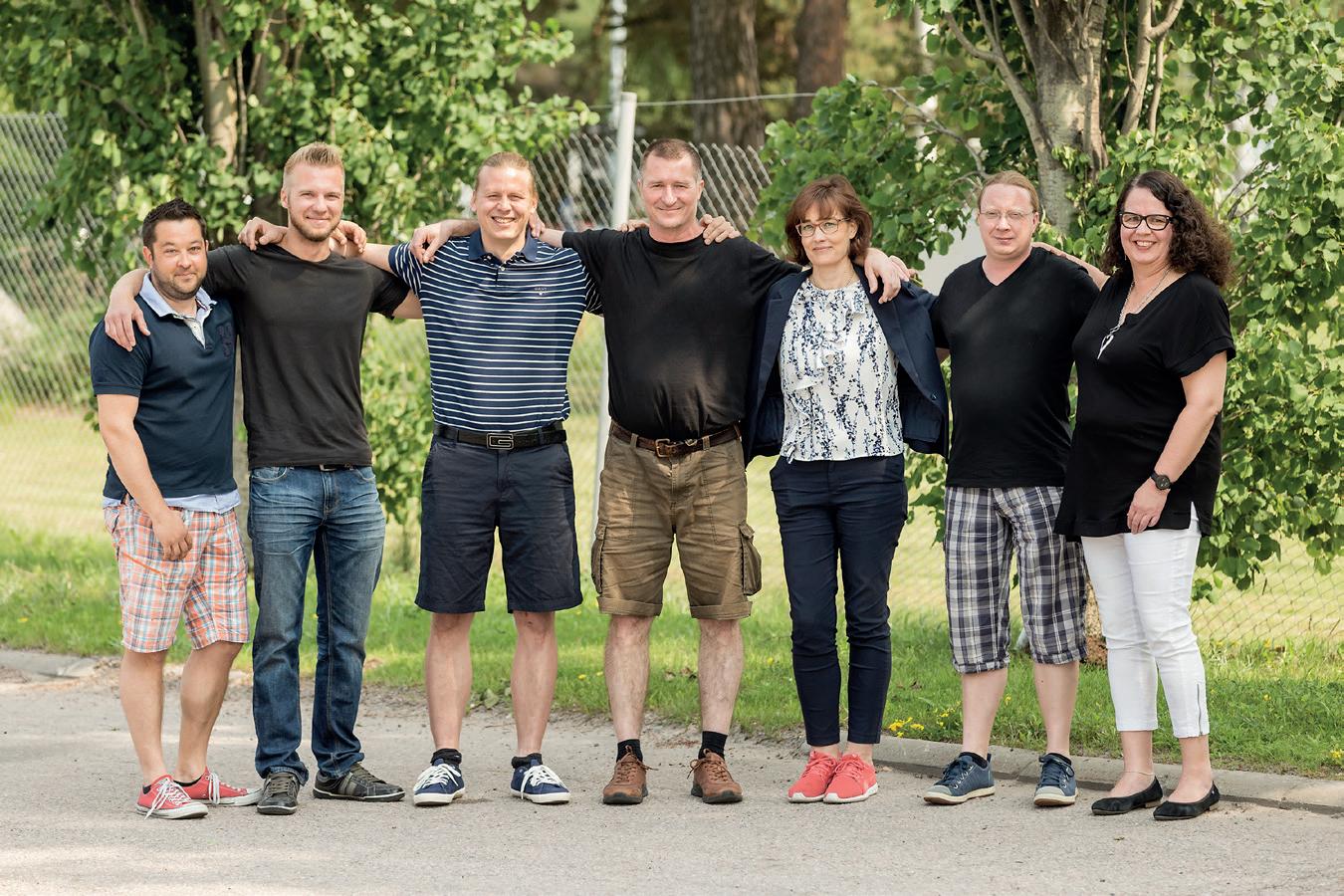
– I visit Vaasa at least once every quarter and have daily contact with the traffic management there. Some can feel that the Finns are breviloquent, but I don’t agree and personally really enjoy my colleagues, Joakim smiles. Together we also conduct a great deal of mutual customer visits.
The market is tough and the importance of being out there with the customers and building relations cannot be overrated, Joakim believes.
Scandic Trans’ head office is located outside Vaasa in Mustasaari, on the Finno-Swedish west coast. Additionally the company has terminals in Turku, Vantaa, Helsingborg and Stockholm. The Scandic Trans property in Turku was built 2003.
– We rented earlier, but after deciding to build our own we have our office and terminal very close to the harbour in Turku. The office and warehouse employ seven people today, tells the office manager Jan Svarfvar.
From the terminal in Turku Scandic Trans runs transport and warehouse business, both in the form of warehouse hotel and loading and unloading of cars run by the company itself, while the office works as kind of a sales office.
– The biggest part of the flow to and from Sweden, Norway and Denmark that needs reloading goes through the terminal in Turku, Jan continues. On the same address there are both warm storage as well as chilled and freeze storage.
– One needs to build a trust, he states. He feels that most people know about Scandic Trans and consider it a well-established, credible and reliable company with a good reputation.
– In addition, we have an extremely good product – we keep our promises. The traffic managers do a fantastic job as well as the drivers. They are our image and our best sellers – they meet with the customers every day. Scandic Trans is considered to be a stable, knowledgeable and safe collaborator.
Joakim Lassen and Alex Proca are stationed at Scandic Logistics in Helsingborg. The subsidiary company focuses mainly on developing the network of collaborators – foreign haulage contractors – to broaden Scandic Trans’ transport network even further.
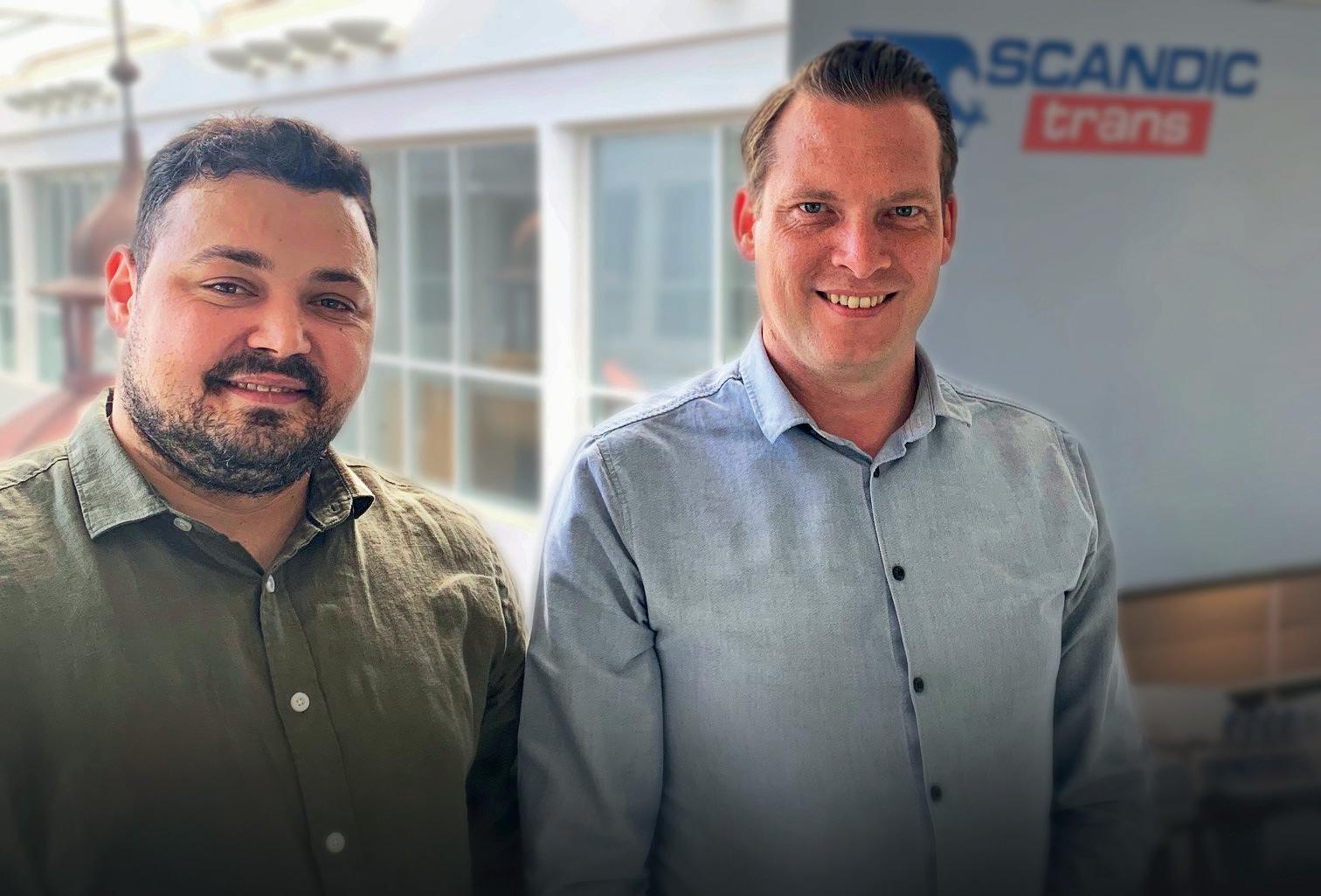
- The long term goal is to have terminal operation i the southern part of Sweden within five years, Joakim states.
According to demand additional investments have been made in order to give the company’s customers the best possible service.
– One example is that the cold storage was expanded to increase the capacity.
At the terminal all kinds of wares are being dealt with –everything from groceries to paper rolls, break bulk cargo of all kinds and also ADR-goods. The cargo volume dealt with at the terminal - both warehouse cargo and ”transit goods” – has increased constantly.
The express traffic is also run from here and four cars run daily between Stockholm and Turku and Helsinki.
– We also have daily distribution routes starting from Turku, Jan adds.
Scandic Trans haulage department has been in Turku ever since the beginning and one person is cur-
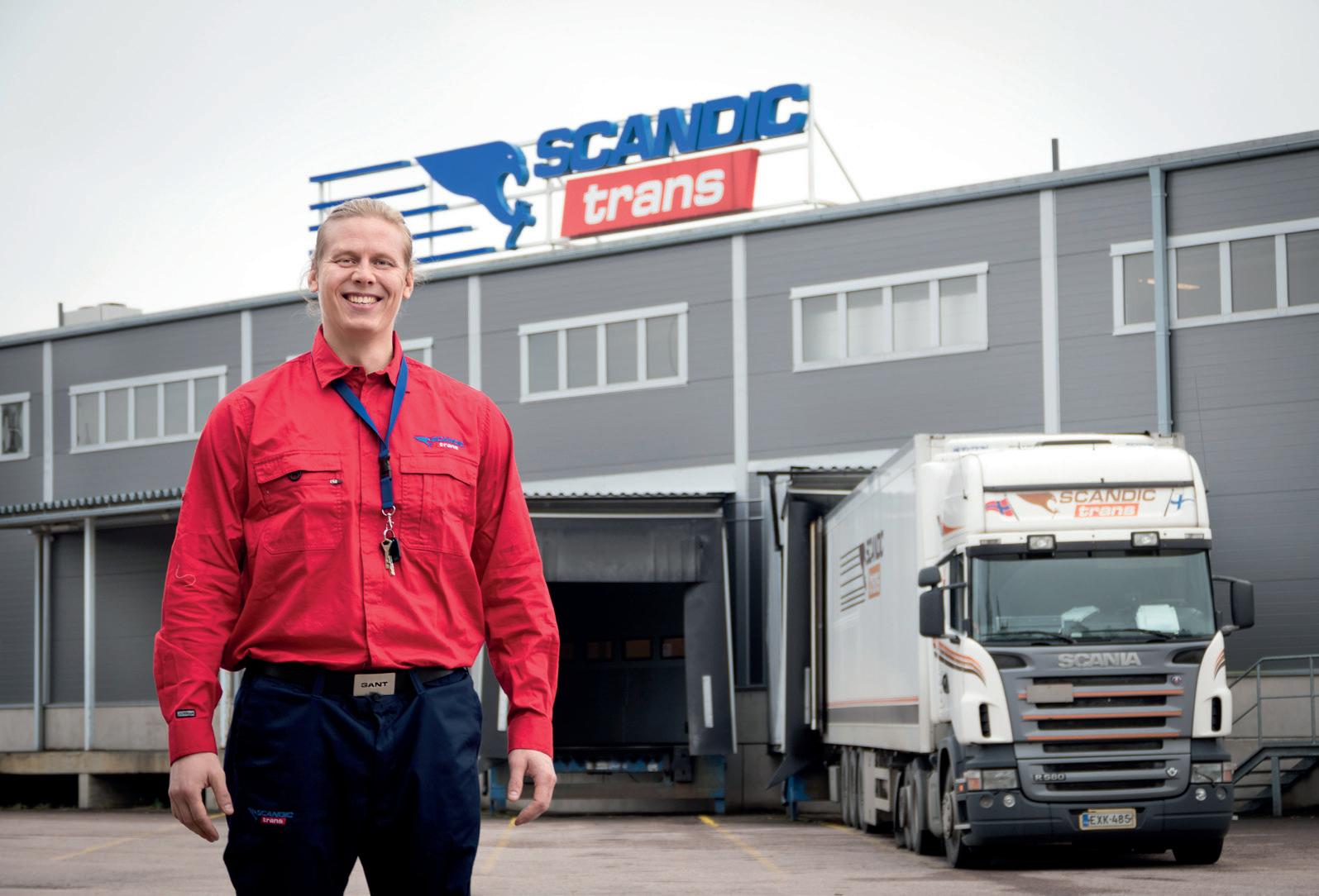
rently employed for dealing with customs issues.
– We also have a salesperson based here in Turku and our IT person is here as well, which is practical considering all the computers in the vehicles, new installations and so on.
When you work with us, your contact always has a name. We’ve chosen to call him Johnny. Although it could just as well be anyone of us. We are all Johnny to you, everyday of the week.
